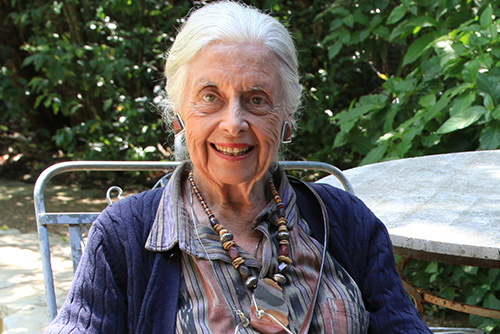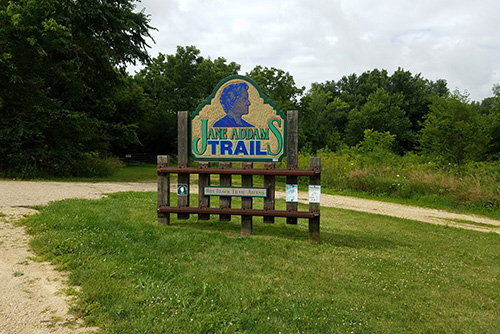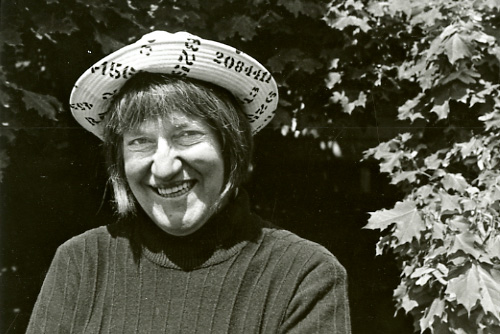10 Trails Named After Influential Women

One of the early pioneers of the rail-trail movement was May Theilgaard Watts, a naturalist and writer who in 1963 penned a letter to the editor of the Chicago Tribune calling for the transformation of a disused Chicago rail line into a multi-use pathway. Watts’ letter would inspire a grassroots effort to develop the Illinois Prairie Path, one of the first rail-trails in the country and a blueprint for hundreds of others to come.
For Women’s History Month, we honor this visionary woman and others who have made extraordinary impacts in their own communities and for the nation. In some cases, their legacy lives on in the names of trails that are used and loved by communities. Here are just 10 to inspire you.
1. Compassionate Conservationist – Terry Hershey Park Hike & Bike Trail (Texas)

Terry Hershey’s first step into the conservation movement began with something close to home that sprinted all the way to the national level with former President George H.W. Bush calling her a “force of nature.” In 1966, Hershey jumped into action after observing the Army Corps of Engineers denuding the banks of the Buffalo Bayou in her Houston neighborhood in preparation for straightening and paving the waterway. She mobilized the community to derail the effort, including enlisting the help of then-congressman Bush. These efforts culminated in the 1970 passage of the National Environmental Policy Act, which requires public input and environmental impact statements for major federal projects. Spanning her beloved Buffalo Bayou, her namesake trail spans more than 10 miles and is one of the city’s most popular outdoor amenities.
2. Nobel Prize Winner – Jane Addams Trail (Illinois)

Born in 1860 in rural north-central Illinois, Jane Addams blossomed onto the international stage as a humanitarian and pioneering social worker. In 1931, she was awarded the Nobel Peace Prize, the first American woman to receive the honor. Her other shining achievements include the 1889 co-founding of Chicago’s Hull House, a settlement facility for recently arrived immigrants, and the co-founding of the American Civil Liberties Union in 1920. The rail-trail which bears her name lies less than 2 miles from Cedarville, where travelers can visit her childhood home and gravesite. The tranquil wooded pathway spans nearly 15 miles and includes trail signage with her likeness.
3. Legacy of Leadership – Helen Boosalis Trail (Nebraska)

Upon becoming mayor of Lincoln in 1975, Helen Boosalis became the first female mayor of a city with a population of more than 100,000. She was no stranger to politics at the time, having served as president of the League of Women Voters and as a city council member for 16 years. She broke barriers again in 1986 as the Democratic matchup against Republican Kay Orr for the Nebraska governorship—the first time in U.S. history when the two major party candidates for governor were women. Though she lost the race, she continued in leadership roles at a diverse range of state and national organizations for the rest of her career. A paved 4-mile trail across Lincoln now bears her name.
4. A League of Her Own – Phyllis Harmon Path (Illinois)

Phyllis Harmon worked for the League of American Wheelman (now known as the League of American Bicyclists) for more than 60 years and dedicated her life to the promotion of bicycling. Although the organization dates back to 1880, it went largely inactive following World War II. In her many roles within the League, Harmon is credited as having a major impact on the revival of the flagging organization in the 1970s and bringing biking back into the American mainstream. She also formed a local Illinois group, the Wheeling Wheelmen, in 1970. In honor of her contributions, the Village of Wheeling dedicated a bike path to her which serves as an important east-west connector in the community.
5. Notable Naturalist – Kim Williams Nature Trail (Montana)

With a degree in human ecology from Cornell University, Kim Williams was a naturalist with a knack for writing, publishing the book Eating Wild Plants (among others) and penning a nature column in The Missoulian. For more than a decade, she also frequently appeared as a guest commentator on the popular National Public Radio program “All Things Considered.” As Williams was a long-time Missoula resident, a riverside rail-trail in the city’s downtown was named in her memory in 1987. The pathway runs by the University of Montana, where she earned a master’s degree and taught classes on plants; today, the school offers a fellowship in her name for journalism students interested in the environment.
RELATED: How May T. Watts Inspired the Illinois Prairie Path and U.S. Rail-Trail Movement
6. Trail Advocate – Mary Carter Greenway (Colorado)

In 1979, as the new leader of a fledgling organization called the South Suburban Park Foundation, Mary Carter spearheaded what would become the flagship trail for an extensive system of trails throughout Littleton and the southern Denver metro area. Their first project was the creation of an 8-mile paved pathway spanning Arapahoe County and included improvements to the South Platte River—Denver’s only river—which the trail parallels. The greenway, which was later named in her memory, now serves as inspirational model for other urban greenways and sees an estimated 500,000 visitors annually.
7. Political Powerhouse – Vera Katz Eastbank Esplanade (Oregon)

Vera Katz and her family fled Nazi Germany in 1933 and settled in Brooklyn, New York. After earning her master’s degree, she moved to Portland, Oregon, with her husband, where her career in politics took off. After being elected to the Oregon House of Representatives in 1972 and serving several terms, Vera Katz became the first woman to hold the role of Speaker of the state House in 1985. She went on to become mayor of Portland, Oregon, serving from 1993 to 2005, and championed the development of the Eastbank Esplanade, which was later named after her. The downtown Portland trail follows the Willamette River for just less than 2 miles. At its southern end, travelers will find a bronze statue of Katz.
8. Exceptional Expeditioner – Sacagawea Heritage Trail (Washington)

Sacagawea is a name that all school children know, and with good reason. The young Shoshoni woman played a critical role in the exploration of America’s Pacific Northwest, which changed the fate of the nation. The 23-mile Sacagawea Heritage Trail in southeastern Washington honors these contributions and provides an opportunity to learn more about her and the vast Corps of Discovery journey. In October 1805, the Lewis and Clark Expedition camped at the confluence of the Snake and Columbia rivers in present-day Pasco, where you can visit a trailside state park and interpretive center that bears her name.
9. The Last Frontier: Anchorage’s First Trail – Lanie Fleischer Chester Creek Trail (Alaska)

Shortly after moving to Anchorage in 1971, Lanie Fleischer co-chaired a newly formed bike committee and galvanized grassroots support for making the city more bike friendly. Surprised by the lack of trails in Anchorage, Fleischer’s work with the group culminated in a master plan for trails that could be used for bike commuting, recreational riding and safe routes to school. In 1973, the group was successful in getting a bond issue passed to finance the development of the city’s first paved trail. The 4-mile pathway, which runs along a lushly wooded Chester Creek, was named after her. Today, the trail system in Alaska’s largest city spans more than 100 miles.
10. She Persisted – Marcia H. Cloninger Rail-Trail (North Carolina)

The beautiful and well-loved rail-trail running through the heart of Lincolnton, North Carolina, might not have become a reality without the tireless persistence of its namesake, Marcia H. Cloninger, who served on the city council in the 1990s and championed the project. The disused rail corridor was once an eyesore, but is now a source of community pride and part of a larger regional effort called the Carolina Thread Trail, which aims to link 1,500 miles of trail across North and South Carolina.

Donate
Everyone deserves access to safe ways to walk, bike, and be active outdoors.